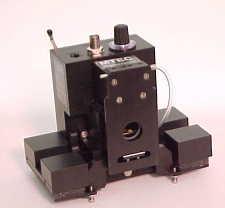|
Instrument Database:
MTEC Photoacoustics, Inc - PAC 300 Photoacoustic Detector
| |
|

|
| |
|
| |
|
| Year of introduction |
|
| Status |
available |
| Company |
MTEC Photoacoustics, Inc
|
| Categories |
Spectrometer ( Molec. ): FTIR
|
The Model 300 (PAC300) photoacoustic detector increases laboratory productivity by quickly measuring FTIR spectra of solid, semi-solid, and liquid samples in any form without sample preparation. The PAC300's operating modes include depth profiling, photoacoustic absorbance, diffuse reflectance and transmittance with capabilities for both macro and microsamples. No other single accessory provides such a wide range of applicability.
- Handles macro- and microsamples with little or no preparation
- Operates in diffuse reflectance, absorbance, and transmittance modes to best fit sample properties
- Automatic purge valve control
- FTIR slide mount compatibility Provides a single accessary solution for most solid and semi-solid analyses
- Allows rapid sample change without breaking FTIR purge
- Operates in all FTIR manufacturer's instruments and spectral regions
- Compatible with qualitative and quantitative FTIR applications software
Optimized Spectra
Solid and semi-solid samples are challenging for FTIR analysis because of their diverse properties: micro to macro sizes, transmitting to opaque optical densities, specular to light-scattering reflectances. Photoacoustic detection provides a cost-efficient, single-accessary approach that accomodates diverse properties and significanlty simplifies FTIR analysis of solids. The MTEC Model 300 handles all samples with little or no sample preparation. It performs infrared absorbance, diffuse reflectance and transmittance measurements as required depending on sample properties by simply exchanging the accessory's sampling heads.
Photoacoustic Detection
Infrared absorbance of samples is measured directly with photoacoustic detection via an acoustic signal that evolves from the sequence of infrared absorption, heat production and thermal expansion. Alternatively, when a black absorber is positioned near the front of or behind the sample, the sample's diffuse reflectance or transmittance spectrum, respectively, is measured as shown schematically on the Sampling Modes page.
Controlled Sampling Depth
When the photoacoustic detector is operated in the absorbance mode, the sampling depth and effective optical density of the sample are independent of the physical sample thickness. The sampling depth is proportional to the squre root of (sample thermal diffuusivity / FTIR mirror velocity due to the signal generation role of the absorption-excited thermal oscillations which decay during propagation through the sample. The net result is that depth-varying information can be obtained by varying the mirror velocity or phase angle of detection.
Multisampler Operation
The MTEC Model 300 has two sampling options which, by the use of interchangeable sampling heads, extend the accessory's capabilities beyond the standard capability of measuring macrosample absorbance spectra. Options Sh003 and SH004 allow the MTEC Model 300 to switch in several seconds between macrosample diffuse reflectance, absorbance, and transmittance measurements and microsample measurements, respectively. The sampling heads are illustrated
schematically on the Sampling Modes page.
|
| Specifications |
|
|
Peak-to-peak noise: less than 0.2% at 2000/cm-1 for 8/cm-1 resolution, 8 scans, OPD velocity 0.1 cm/s, MTEC carbon black sample and without FTIR-imposed limitations.
Microphone nominal sensitivity: 50 mV/Pa.
Mirror focusing factor: 2 to 1.
Spectral range defined by window material: (KBr standard, UV to 400/cm).
Gain range: 2-10,000 in 12 steps.
Slide: mountable.
Maximum sample size: 10mm diamter X8mm height.
Provision for helium-purged and desiccated sample chamber with automatic purge valve operation.
6 cm minimum FTIR base-plate-to-beam center distance.
Shipping weight 5 kg.
|
|